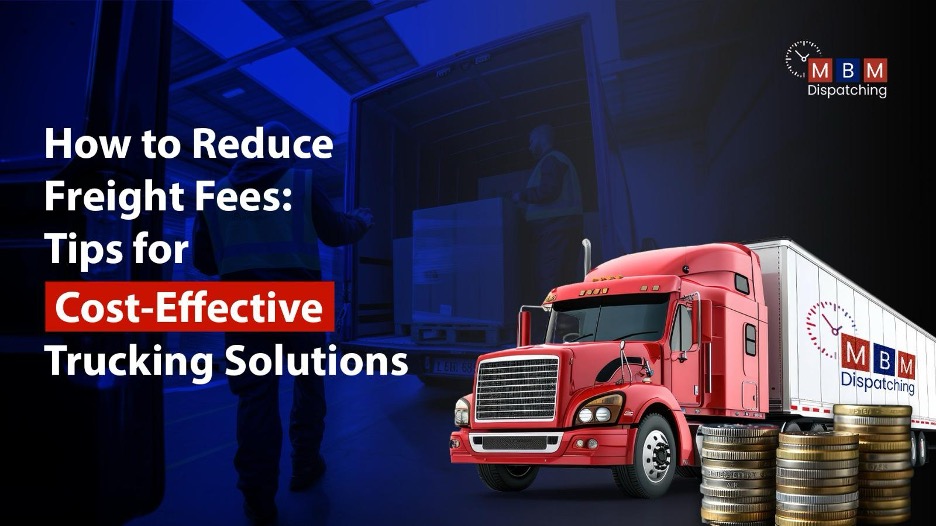Freight fees are climbing, affecting not only logistics providers and transport services but also businesses relying on efficient supply chain management. These rising costs strain budgets, cut into profit margins, and reduce competitiveness for trucking companies and logistics businesses across the board. As fuel prices, labor costs, and regulatory fees increase, logistics chain management becomes more complex and costly, impacting overall operations and supply chain management.
High freight fees can feel like an unavoidable cost of doing business in trucking and logistics. These fees impact cargo transport, dispatching, and other vital logistics and management operations, making it challenging for companies to offer affordable services. For small trucking companies and even major third-party logistics providers, freight fees can restrict growth and profitability, leaving business owners searching for ways to make their logistics services more efficient.
Reducing freight fees doesn’t have to be a daunting task. Through efficient route planning, optimized loads, and leveraging technology solutions, trucking companies, and logistics businesses can streamline their operations, cut costs, and ultimately provide cost-effective services in the logistics transportation industry. This guide provides practical steps for reducing freight fees, allowing companies to maintain their competitive edge.
1. Understanding Freight Fees
Freight fees are influenced by various factors, including fuel prices, distance, load weight, labor, and tolls. For logistics and management companies, these fees are a crucial part of overall pricing but can quickly become a significant expense if not carefully managed.
For example, a trucking company operating in logistics transportation will need to calculate costs associated with each shipment. These fees include fuel costs, maintenance of the truck and trailer, driver wages, and additional expenses like tolls and regulatory fees. Understanding these costs is essential for logistics businesses to effectively control freight fees and optimize their logistics and supply chain operations.
2. Tips for Reducing Freight Fees
a. Optimize Route Planning
Effective route planning is one of the most effective ways to reduce freight fees. Poor route planning leads to increased mileage, higher fuel consumption, and unnecessary costs. GPS systems and modern logistics software provide valuable tools for managing transportation and logistics more efficiently.
- Implementing GPS technology can help trucking companies find the most fuel-efficient routes, avoiding traffic and reducing travel times.
- Logistics providers can also invest in route optimization software, which considers factors like load weight, delivery times, and truckloads, to plan the most cost-effective routes.
Using optimized routes not only helps lower freight costs but also improves overall logistics management by ensuring timely deliveries.
b. Maximize Load Efficiency
Maximizing load efficiency is essential for reducing empty miles and ensuring that each truck operates at full capacity. By coordinating truck loads and optimizing the weight distribution, trucking companies can cut down on unnecessary trips, lowering freight fees.
- Consider full truckloads (FTL) whenever possible, as these are typically more cost-effective than less-than-truckload (LTL) shipments.
- Use load boards to identify backhauling opportunities, which reduce empty miles by coordinating return shipments, further lowering freight fees.
Maximizing load efficiency not only reduces costs but also contributes to the sustainability of the trucking industry by minimizing fuel consumption.
c. Leverage Backhauling Opportunities
Backhauling involves arranging for a return shipment on a truck’s return journey, reducing empty miles and lowering overall transportation costs. Logistics companies and third-party logistics providers can collaborate to identify backhauling opportunities, which add an additional revenue stream while lowering freight expenses.
- Work with other trucking companies or a freight broker to maximize backhaul opportunities.
- Use technology platforms that help coordinate backhauls, making it easy for companies in logistics and services to cut down on empty travel miles.
Backhauling is an efficient logistics and management practice that can lead to significant savings for logistics businesses.
d. Maintain Your Fleet Regularly
Regular fleet maintenance is a proactive approach to reducing freight fees by avoiding unexpected breakdowns and inefficient fuel consumption. Proper maintenance ensures that trucks are operating at peak performance, reducing fuel costs and extending the life of the vehicle.
- Conduct regular tire checks, oil changes, and engine inspections to ensure optimal performance.
- Address minor issues promptly to prevent costly breakdowns, which not only incur repair costs but also lead to delays and customer dissatisfaction.
By investing in regular fleet maintenance, logistics companies can enhance their efficiency and reduce costs associated with unexpected repairs.
e. Choose the Right Freight Provider or Partner
Selecting the right freight provider or logistics partner can make a significant difference in managing freight fees. By comparing costs, evaluating service levels, and selecting providers who align with the business’s goals, companies can secure better rates.
- Evaluate freight providers based on their service quality, reliability, and rates.
- Consider third-party logistics providers who specialize in specific areas like truck transport or cargo shipment, which can be more cost-effective than using a general provider.
An efficient logistics provider can streamline the logistics transportation process, helping businesses cut costs without sacrificing service quality.
f. Optimize Load Weight and Packaging
Optimizing load weight and packaging can help reduce freight fees by minimizing wasted space and reducing unnecessary weight. This is particularly relevant for companies in logistics and supply chain management that handle high volumes of cargo shipments.
- Use efficient packaging techniques to make the best use of available space.
- Distribute load weight evenly to improve fuel efficiency and avoid additional costs due to overweight trucks.
Effective packaging and load management can enhance the cost-effectiveness of trucking operations, making logistics transportation more affordable for businesses.
g. Negotiate Freight Contracts Effectively
Long-term freight contracts can help logistics and management companies secure stable rates, even when market prices fluctuate. Effective negotiation with freight providers can result in cost savings, allowing businesses to lock in favorable terms.
- Small logistics companies can benefit by negotiating bulk shipping contracts, securing better rates.
- Consider long-term commitments to get lower rates, which helps reduce freight fees over time.
By establishing favorable freight contracts, logistics businesses can better manage costs and ensure sustainable operations.
3. Technology Solutions for Cost-Effective Trucking
Technology offers numerous solutions for trucking companies and logistics businesses aiming to cut costs. From fleet management software to real-time data analytics, technology can streamline logistics and services, enabling companies to make data-driven decisions and optimize their supply chain.
- Fleet management systems allow logistics companies to track truck loads, monitor fuel usage, and predict maintenance needs.
- Data analytics tools provide insights into route performance, fuel efficiency, and cost-saving opportunities, making logistics chain management more efficient.
Implementing technology in a logistics business enables operators to make smarter, more informed decisions, reducing costs and enhancing overall efficiency.
4. Environmental and Fuel Efficiency Practices
Eco-friendly practices not only help reduce fuel usage but also contribute to a positive brand image. Many trucking companies are adopting sustainable practices to reduce their environmental impact and operational costs.
- Encourage drivers to adopt fuel-efficient driving practices, such as avoiding rapid acceleration and maintaining a steady speed.
- Consider alternative fuels or energy-efficient vehicles, if feasible, for a long-term reduction in fuel expenses.
Implementing eco-friendly practices helps logistics businesses in operations management and supply chain management by reducing fuel costs and supporting sustainable practices.
5. Collaborate with Third-Party Logistics (3PL) Providers
Third-party logistics providers (3PLs) offer specialized logistics services, such as warehousing, transportation, and inventory management. By working with 3PLs, companies in logistics and supply chain management can reduce overhead costs and focus on core business operations.
- 3PL providers can help manage freight fees by negotiating better rates and optimizing shipping routes.
- Outsourcing to a 3PL can streamline operations, allowing logistics businesses to focus on customer satisfaction and strategic growth.
For companies looking to optimize their logistics transportation operations, 3PL providers offer a practical, cost-effective solution.
Conclusion
Reducing freight fees is an achievable goal for logistics companies, trucking operators, and others in the supply chain industry. By following these tips—optimizing routes, maximizing load efficiency, leveraging backhauls, maintaining fleets, selecting the right partners, using technology, adopting sustainable practices, and collaborating with 3PL providers—businesses can successfully lower freight fees, improve profitability, and offer competitive pricing in the logistics transportation industry. Embracing these strategies enables companies to streamline operations, meet customer demands, and position themselves as leaders in cost-effective logistics and supply chain management.

